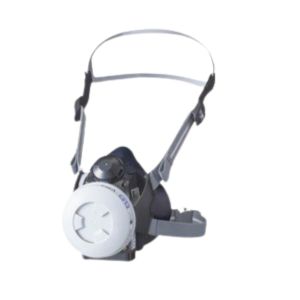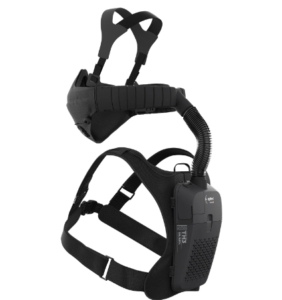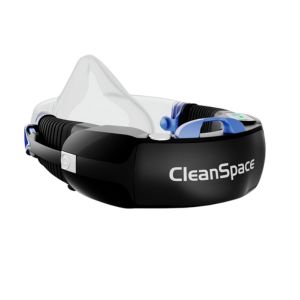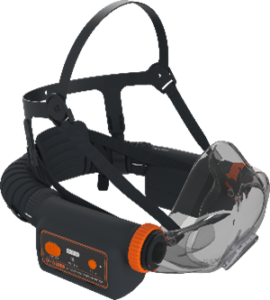When it comes to half-face respiratory protection from dust, typically there are 3 options:
1. Disposable paper mask, commonly N95 paper mask or filtering facepiece respirator (FFR).
2. Elastomeric reusable non-powered air-purifying respirator (NAPR).
3. Powered air-purifying respirator (PAPR).
Option 1 is the most common type of respirator, where the ‘Cup’ shaped mask is made of non-woven filter media and thus functions both as a barrier and as an air filter.
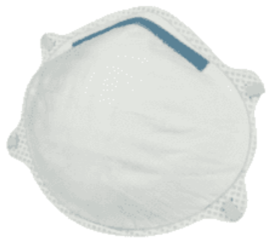
It is simple, light, low-profile, and can be mass-produced efficiently; however, it has the following key drawbacks:
- The seal is prone to leak, as the facial contact is made from non-woven fiber that is not elastic with a low fit factor and cannot maintain a reliable seal with facial movement.
- Typically, P2 grade is most practical from a flow resistance point of view due to the limited effective usable area of the mask, and P3 grade media will likely make it too restrictive to breathe comfortably.
- The Assigned Protection Factor (APF) is only 10 for P2 FFR. For hazardous dust such as welding fumes, it is considered inadequate.
- It is a disposable type and is not designed for reuse. Outside dust tends to accumulate around the mask seal due to negative pressure inside the mask, making it dirty to reuse the next day. Your breath will also contaminate the filter media with moisture and smell, increasing flow resistance to breathe against, and allowing bacteria to grow. Depending on how dusty and physical exertion is, it may need to be replaced in a few hours or daily.
- You must be clean-shaven.
Option 2 improves some drawbacks of Option 1, where:
- The elastomeric cushion improves the fit factor and seal during use.
- The filter and the elastomeric mask are reusable, making it environmentally friendly and potentially saving costs for frequent use in dusty environments.
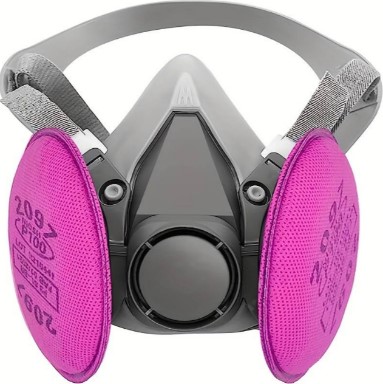
However, Option 2 still has the following drawbacks:
- Although the flow resistance of the filter of a NAPR can be made lower by making the filter cartridge bigger, being a negative pressure respirator, the APF is still at 10 regardless of whether a P3 grade filter is used.
- Being a negative pressure respirator, your lungs are still burdened by the flow resistance of the filter, making it not very suitable for high exertion work, as the flow resistance is proportional to the flow rate which is determined by the level of exertion of the work involved.
- You must be clean-shaven to ensure the expected protection, and you are also recommended to do annual fit testing to make sure the fit factor is still adequate.
Option 3 improves most of the drawbacks of Option 2, where:
- There is no flow resistance when the pressure inside the mask is positive, which is the case in normal and non-high exertion work where the flow rate from breathing is within the flow capacity of the PAPR.
- Higher APF can be achieved up to 1000.
- You may be able to keep a short and well-trimmed beard, provided you do fit testing at least once to make sure a fit factor of over 1000.
So based on the above comparison, PAPRs are the best option as far as protection is concerned.
However, not all PAPRs are equal:
-
- They vary with APF levels, some are not significantly higher than a NAPR, such as a loose-fitting PAPR.
- Other factors such as wearability, mobility, flow capability, and cost will affect whether a particular PAPR is suitable for a given work.
Here is a comparison of popular types of PAPRs on the market for dust protection:
| PAPR Type | Brand/Model | Key Comparison |
| Face-mounted Tight-fitting |
SHIGEMATSU Sync11VP3
|
Protection level: AS/NZS 1716 PAPR P3
|
| Belt-mounted Tight-fitting |
Sundstrom SR700/SR900
|
Protection level: AS/NZS 1716 PAPR P3
|
|
Back-mounted Loose-fitting |
Optrel Swiss Air System
|
Protection level: EN12941 TH3
|
|
Around-neck Tight-fitting |
CleanSpace Works
|
Protection level: AS/NZS 1716 PAPR P3
|
|
Around-neck Tight-fitting and loose-fitting configurable |
Aimwell AYO WX HFM Half-Face Mask PAPR System
|
Protection level: AS/NZS 1716 PAPR P3, MPF: >100
|
From the table above, Aimwell AYO WX HFM Half-Face Mask PAPR System is a clear winner among common half-face mask PAPRs on the market in terms of overall performance for dust protection.
You may wonder why Aimwell AYO WX HFM PAPR System comes only at a fraction of the cost of most PAPRs while achieving the best overall performance on the market.
You can better appreciate it with our mission as a company: to make you breathe safer and better. We mean it by striving to innovate the technology, the design, and the manufacturing process to make the product work better and cost less.
In the case of Aimwell AYO WX HFM PAPR, firstly the technology used is unique and among the most advanced in the world, then we went a step further to make the overall product cost less by optimizing the design for a low-cost manufacturing process, and we went even further to make the running cost very low by providing an unconventional pleated pre-filter not seen in other respirators.
As a result, the running cost of Aimwell AYO WX HFM PAPR is so low, that within 12 months, its total cost after purchase will be less than that for a common NAPR.
In summary, Aimwell AYO WX HFM Half-Face mask PAPR System has the following properties:
- Best-in-class protection and lowest-in-class cost.
- Great wearability and mobility – can be worn just like a common NAPR.
- Comfortable to breathe – once you have used Aimwell AYO WX HFM PAPR, you will not want to go back to NAPR.
- Easy to clean and maintain – flush wash compatible.
- Less demanding on clean-shaven with a Loose-Fitting Face Seal as an Add-on option.
- Cheaper than using a NAPR.
So if you are looking for the best half-face respirator for dust protection, look no further than Aimwell AYO WX HFM PAPR.
Aimwell AYO WX HFM PAPR is ideal for protecting the following: Asbestos, silica dust, metalliferous dust, powder coating dust, coal dust, and sawdust.
Upgrade from NAPR to Aimwell AYO WX HFM Half-Face Mask PAPR System now for better protection, better comfort, and cost savings.

